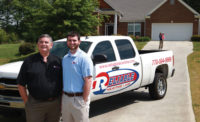President Donald Trump’s decision to pull the United States out of the Paris climate agreement made headlines, but the Montreal Protocol – and particularly its 2016 Kigali amendment –potentially affects the HVACR industry in a much larger way. Or not. Because at this point, no matter what the government does it’s unlikely to have much of an effect on the water-rushing-downhill force of the low-GWP movement.
By way of a very basic refresher, the Paris agreement was a voluntary effort to have countries around the world step up and proclaim how much of a reduction in atmospheric carbon dioxide emissions they would strive to achieve over the coming decades. It was significant for the fact that more than 190 countries signed on, and it brought the desire to address climate change squarely into the international spotlight. However, there was no real enforcement mechanism, other than what essentially amounted to peer pressure between countries.
The Montreal Protocol, on the other hand, is a binding international treaty. First signed in September 1987, is the only treaty in the United Nations system to which every country is a signatory. It was originally created to address ozone depletion, and that led to the phaseout of CFCs and HCFCs. Now it has broadened its scope into the realm of climate change, and the Kigali amendment calls for a reduction in greenhouse gases that includes a massive phasedown of HFCs globally over the next 35 years.
To date, the Trump administration hasn’t said much about the Montreal Protocol or the Kigali amendment. But even the most fervent climate change skeptic would have to acknowledge that no matter what the U.S. government does at this point, the HVACR industry has proceeded too far down the low-GWP road to turn around and go back. Depending on the application, the industry is moving – or already has moved – to natural refrigerants (such as ammonia or carbon dioxide), hydrocarbons, or HFOS. The technological explosion that is taking place now in refrigeration is another great example of this industry’s ability to hit a curve ball, no matter how nasty.
In addition, the world has embraced the low-GWP movement. France recently joined Spain, Denmark, Norway, and Slovenia in taxing HFCs. The French tax is anticipated to be about 30 Euros per ton of CO2 equivalent, and could apply to about 12 million tons in 2018. Outside of taxation, numerous other countries have fiscal incentive plans available to encourage businesses to adopt low-GWP alternatives. In the U.S. the Sacramento Municipal Utility District has announced the launch of a new pilot program that will provide financial incentives for direct greenhouse gas emission reduction. The program is open to SMUD’s commercial customers that install new natural refrigerant system or retrofit a system from a high-GWP refrigerant to a natural refrigerant.
At a just-concluded annual meeting of the Parties to the Montreal Protocol held in Bangkok, discussions centered around how to implement the international agreement, including funding for the Kigali objectives. That meeting was preceded by a workshop on safety standards for low-GWP alternatives to HFCs. Here in the U.S., the Air-Conditioning, Heating, and Refrigeration Institute has been hard at work on researching alternative refrigerant safety through its Low-GWP Alternative Refrigerants Evaluation Program. And the industry’s leading refrigerant manufacturers are investing millions of dollars in new plants to produce low-GWP HFOs and blends.
The bottom line is people aren’t talking about doing things anymore – they’re doing things. We’re past the talking phase and well into the implementation phase. Despite the exit from the Paris agreement, the HVACR train has left the station when it comes to HFCs. HFCs were great refrigerants, and they’ll continue to be in use for many years – albeit at what are likely to be steadily dwindling supplies and steadily increasing prices. But there’s new low-GWP technology on the market, in development, and on the horizon.
The United States may or may not pay a price in technological leadership for exiting the Paris agreement. Only time will tell. But as far as the Kigali amendment and leadership in new low-GWP refrigerant technology, it is full steam ahead for the HVACR industry for the foreseeable future.
Publication date: 8/2/2017
Want more HVAC industry news and information? Join The NEWS on Facebook, Twitter, and LinkedIn today!











